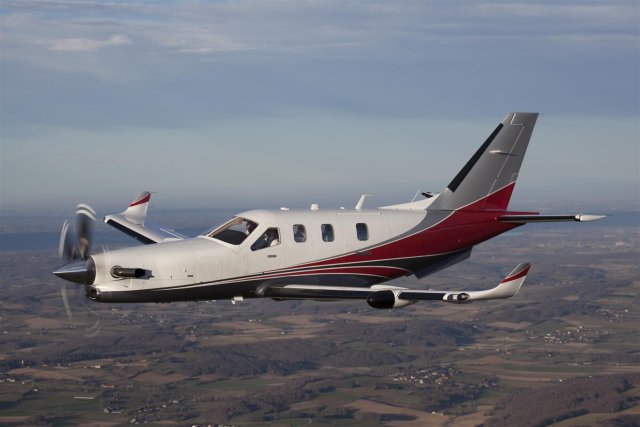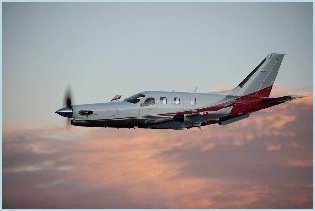Daher-Socata TBM 900
| a | ||||||||||||||||||||||
|
DAHER SOCATA TBM 900 utility aircraft
|
||||||||||||||||||||||
|
|
||||||||||||||||||||||
 |
||||||||||||||||||||||
|
|
||||||||||||||||||||||
|
The DAHER-SOCATA TBM 900 is a high performance single-engine turboprop light utility aircraft manufactured by the French company DAHER-SOCATA. It is an aerodynamically refined version of the famous TBM 700 and 850 airplanes and is marketed as the TBM 900 from March 2014.
Daher TBM 900 is currently the world’s fastest single-engine turboprop aircraft. Daher’s vision of the role of an aircraft manufacturer encompasses the design, production and support as well as maintenance, repair and technical monitoring. The TBM, which combines cruising speed and trip time of a light jet with the economic direct operating cost, range and endurance of a turboprop engine, offers multiple applications for government, parapublic and professional operators, with the flexibility to perform such missions as : intelligence, surveillance and reconnaissance (ISR), medical evacuation, passenger transportation, and training and cargo. To date, more than 713 TBM family aircraft have been sold worldwide. The global TBM fleet has surpassed the combined 1.2 million flight hour milestone, with overall fleet usage now averaging in excess of 120,000 flight hours annually. To date, more than 30 TBM 900s have already been delivered and Daher Socata is presently planning on a production rate of 50 aircraft per year at its production facility, in Tarbes, southwestern France. |
||||||||||||||||||||||
| Main Variants | ||||||||||||||||||||||
|
-
|
||||||||||||||||||||||
| Technical Data | ||||||||||||||||||||||
| Design | ||||||||||||||||||||||
|
The TBM 900 airframe design employs several fail-safe structural design techniques, including the use of multiple load paths and a crack-stopper band to maximize sub-system reliability/durability and structural life. The TBM 900 airframe builds on the success of the TBM 850 and the TBM 700. TBM 900 airframe designers carefully chose a variety of aluminum alloys, high strength steel (including titanium) as well as advanced composite materials to maximize structural strength and durability, while minimizing not only aircraft weight but also acquisition and life-cycle support costs. The majority of the TBM structure is manufactured from conventional aluminum alloys. The exceptionally strong wing spars, flap tracks and windshield frames are machined from solid bars of aluminum. The TBM 900 uses advanced composite materials such as carbon fiber for its winglets and its enhanced cowlings which maximize its structural strength and durability while minimizing weight.
The new wingtips give the TBM 900 its new signature look and coupled with aerodynamic improvements to the ailerons, vertical stabilizer and new inner gear doors significantly reduce drag while improving low speed and high angle of attack handling in flight. The TBM 900 tail cone has been restructured making it more streamlined reducing drag and improving airframe efficiency. To improve visibiliy at night, Socata added an additional light at the tip of the tail of the aircraft. This gives improved lighting around the TBM900 to enhance visibility of the TBM 900 by other aircraft in low-light conditions. |
||||||||||||||||||||||
|
Propulsion
|
||||||||||||||||||||||
|
The TBM 900 is powered by the reliable Pratt & Whitney Canada PT6A engine. The PT6A-66D model used on the TBM 900 has a thermodynamic rating of 1,825 horsepower and a flat-rated output of 850 shaft-horsepower making it one of the most powerful PT6A engines built to date. TBM 900 doesn’t have a 700-shp limitation for takeoff, as did all previous TBM models. The TBM 900, with a cruise speed of 330 KTAS (611 km/h) at FL280 (in ISA conditions), gives owners and pilots the advantages of the typical cruising speeds of light jets, with the economical direct operating costs of a single-engine turboprop. Approaching at only 90 KIAS or less, short runways or short unpaved surfaces will accommodate the TBM 900. The new 5-blade Hartzell propeller reduces noise and improves take off performance. The availability of thrust reversal on the TBM 900 substantially improves safety margins over aircraft without these capabilities when flying into shorter fields, (particularly when the surface is wet) allowing landing on extremely short strips and runways safely using less than 2,430 ft. The TBM 900’s new exhaust has been redesigned for better efficiency resulting in maximizing the airflow through the engine and improving high-altitude performance. Maximum takeoff weight for the TBM 900 is 3,354 kg. (7,394 lb.), with a maximum payload of 703 kg. (1,550 lb.) for its ISR version.
|
||||||||||||||||||||||
|
Avionics
|
||||||||||||||||||||||
|
Based on the other aircraft of the TBM familiy, the TBM 900 is fitted with a new reclined panel, with its better instrumentation improves your flying experience and comfort. Avionics now feature the Garmin G1000 system, with three screens. The outer pilot flying Displays (PFDs) both have a 10.4” screens, while the central multifunction display (MFD) features a 15” screen. The G1000 supports a wealth of advanced avionics options, including an advanced autopilot with automatic yaw trim, controller pilot data link control (CPDLC), synthetic vision technology (SVT), GPS/WAAS for the satellite-based approach system (SBAS) for approaches at austere airfields and satellite-based weather reports. A new 28V/300A starter-generator system now supports the avionics.
Instrument descriptions and labeling have been re-engineered which makes instrumentation reading essentially easy and yields more panel room for sight comfort. The new ergonomic yoke fits your hand like a glove. Integrated pushbuttons for features like Control Wheel Steering, ATC Ident, Stormscope and Com frequency swap puts everything at pilot's fingertips. The redesigned panel includes 2 built-in USB power ports as well as a conventional 12V charger socket to keep your personal electronics fully charged. The TBM 900 is the first single-engine turboprop to feature single lever control. A single, ergonomically designed lever controls the engine power, propeller and engine condition. In addition, its new electronic power center allows the TBM 900 to start almost twice as fast as its predecessors and automatic starter cutoff reduces pilot workload during the startup sequence. The lower panel has been redesigned to provide easier access to de-icing, intertial seperator and other controls as well as to provide more leg-room for taller pilots. Pressurization settings are now completely automatic. The landing gear control system has been redesigned for easy identification of gear status and to ease troubleshooting. |
||||||||||||||||||||||
| Mission capabilities | ||||||||||||||||||||||
|
As the TBM 850, the TBM 900 is perfectly adapted to perform a whole range of missions. In its ISR variant, dubbed, TBM MMA (Multi-Mission Aircraft), the airplane offers an integrated solution to perform airborne surveillance, law enforcement, counter-smuggling, environment assessment, rescue and training misions. The ISR variant can accomodate three crew members with a full fuel load. The configuration of the aircraft allows rapid reconfiguration thanks to a quick change system. This allow the same sensor to be used on several aircraft, while allowing the swap-out of sensors on a TBM aircraft. The TBM MMA can perform discreet operations, thanks to its retractable system, which remove the sensor turret from sight when not in operation. The electrically-driven turret is capable of accommodating all leading-edge infrared and electro-optical systems up to 15 inches diameter (Wescam, Flir Systems, etc.), along with a laser options to mark targets. When deployed, the turret offers 360-degree optimal viewing and can carry many sensors – with the ability to remove equipment for a quick-change transfer to another aircraft. It is characterized by its discretion due to its fully retractable electric turret located under the rear fuselage. It can thus integrate the latest generation of cameras like FLIR Systems Star Safire 380 HD and L-3 Wescam MX ™ 15. Both are high-definition fully digital multi-sensors with infrared and electrooptical/infrared (EO/IR) systems for security and defense operations. The TBM 900 MMA can also combine radar Thales I-Master Synthetic Aperture Radar (SAR) and Ground Moving Target Indicator (GMTI). IMASTER weighs only 65 lbs. (30 kg.), and provides an optimized balance of capability, weight and performance in the world’s leading lightweight tactical surveillance radar. The TBM-MMA turret’s mission information can be combined with other SAR/Ground MTI/Maritime radar, sucha as the Selex ES Seaspray.. |
||||||||||||||||||||||
| Specifications | ||||||||||||||||||||||
|
||||||||||||||||||||||
|
||||||||||||||||||||||































